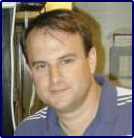Hunting Pre-Cancerous Cells in the EsophagusPowerful Patient, 2009 Week 6Host: Joyce Graff, http://powerfulpatient.org, editor@vhl.org 800-767-4845
Joyce Graff speaks with Adam Wax about his new light probe technology which can examine cells for pre-cancerous changes. This holds hope for early detection of cancer of the esophagus, and can also be used to measure whether a drug therapy is working.
About Our Guest
Adam Wax holds a Ph.D. in physics from Duke University. He is an Assistant Professor of Biomedical Engineering at the Fitzpatrick Institute of Photonics at Duke University in Durham, North Carolina.
http://www.fitzpatrick.duke.edu/adamwax.html You can reach him at a.wax@duke.edu
About his researchThe study of intact, living cells using non-invasive optical spectroscopic methods offers the opportunity to assess cellular structure and organization in a way that is not possible with traditional methods. We have developed a novel spectroscopic technique for diagnosing disease at the cellular level based on using low-coherence interferometry (LCI) to detect the angular distribution of scattered light.
Angle-resolved LCI (a/LCI) enables quantitative measurements of changes in the size and texture of cell nuclei which are characteristic of pre-cancerous cells. We have used an animal carcinogenesis model to demonstrate that a/LCI can detect pre-cancerous changes in epithelial cells within intact tissue samples without the need for fixing, mounting, or staining the cells.
The potential of a/LCI as a noninvasive means for investigating the development of pre-cancerous tissue states appears high. This technique also may provide a new screening tool for clinical diagnosis of the earliest stages of cancer.
About the article
The results of the Duke’s team’s experiments were published in the February issue of Cancer Research.
“Light Scattering Measurements of Subcellular Structure Provide Noninvasive Early Detection of Chemotherapy-Induced Apoptosis,” by Kevin J. Chalut, Julie Hanson Ostrander, Michael G. Giacomelli and Adam Wax
http://cancerres.aacrjournals.org/cgi/content/abstract/69/3/1199
In a press release from Duke University, Julie Ostrander is quoted concerning her experiments with a/LCI on breast cancer cell lines in the lab. “Now, oncologists typically judge if a chemotherapeutic agent is working by looking for shrinkage in the tumor using imaging techniques such as MRI or PET, or pathological response at the time of surgery,” said Julie Ostrander, Duke molecular cancer biologist, who along with Duke bioengineer Kevin Chalut were the paper’s first authors. “If we had a way to detect early on in the apoptotic process whether or not a drug was working, patients would not have to wait weeks to months to find out. The idea that you could shine a light at a tumor and use the light-scattering pattern to measure the success of drugs is a big step forward.”
Ostrander said that this technology will help laboratory investigators like her determine how cancer cells become resistant to apoptosis, and therefore are resistant to drug therapy. Before this technique can be employed for human breast cancer, further studies will be carried out in animals.
The light used to examine the cells must “see” into the cells, so they either need to be within a few millimeters of the light, or cells must be retrieved using biopsy techniques such as fine needle aspiration (drawing some cells from the tumor into a syringe). Wax and colleagues at the University of North Carolina at Chapel Hill are currently conducting a pilot clinical trial in humans using a similar technology for early detection of pre-cancerous cells in the epithelial lining of the esophagus, a condition known as Barrett’s Esophagus. Just as colonoscopy examines the lining of the bowel, endoscopic examination of the esophagus with a light probe is feasible as a doctor’s office procedure.
About Barrett’s Esophagus (from Wikipedia)
Barrett's esophagus (UK: Oesophagus) (sometimes called Barrett's syndrome, CELLO, columnar epithelium lined lower oesophagus or colloquially as Barrett's) refers to an abnormal change (metaplasia) in the cells of the lower end of the esophagus thought to be caused by damage from chronic acid exposure, or reflux esophagitis. Barrett's esophagus is found in about 10% of patients who seek medical care for heartburn (gastroesophageal reflux). It is considered to be a premalignant condition and is associated with an increased risk of esophageal cancer.
About Oncoscope, Inc.
Dr. Wax and his colleagues have formed a commercial company to bring this technology to market with a device that can be used in a doctor’s office or clinic. They are working toward FDA approval, and hope to be in the market by 2010. For more information, see http://www.oncoscope.com/
|
